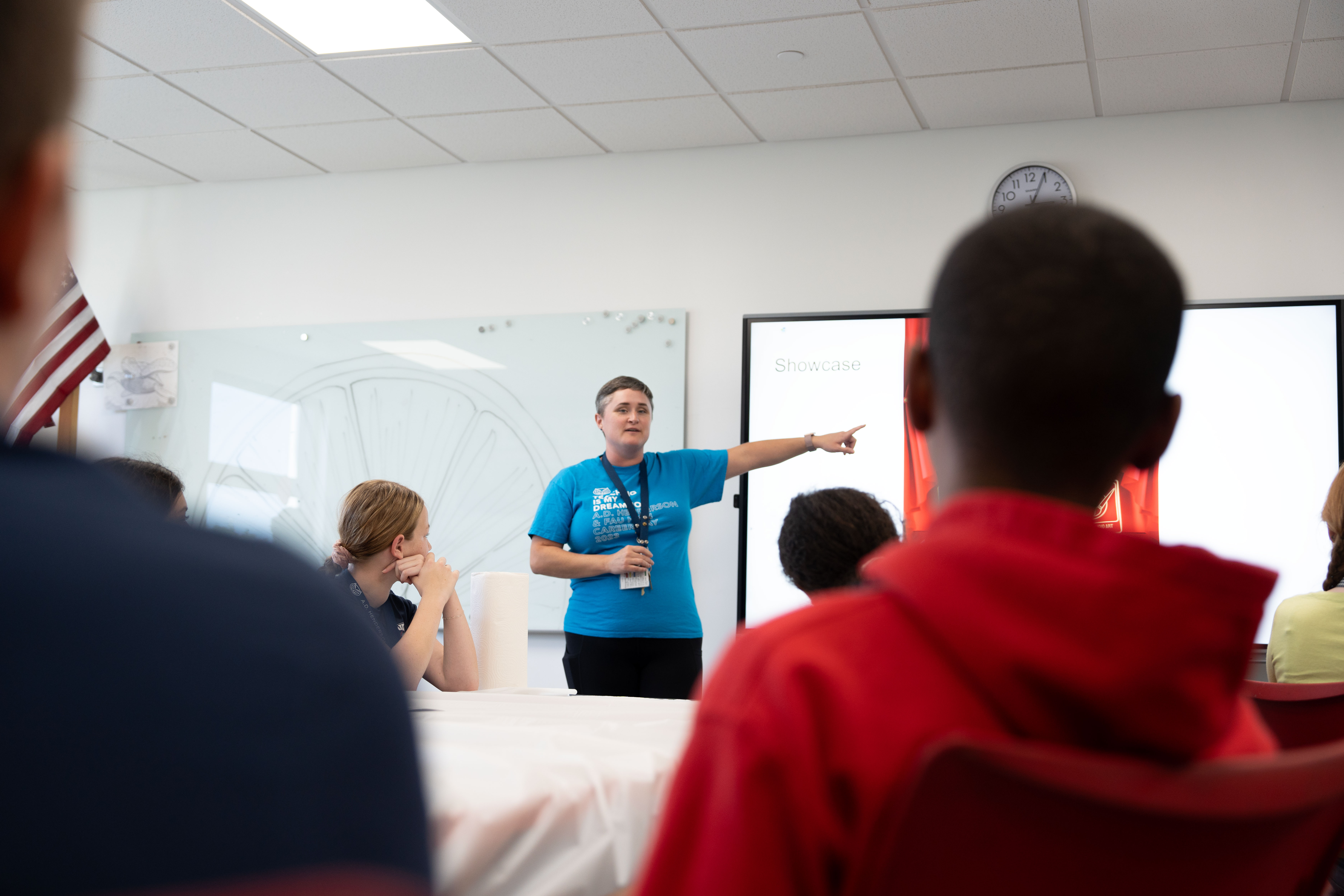Rationale
Our research investigates the benefits of creative expression in an after-school club called Studio Sessions. Our student population is stressed due to academic and personal pressures. Students do not have school-sponsored creative outlets. Students also lack a sense of belonging with peers across grade levels (Middle to High, within the HS program - Sazone & Perez, 2019). By increasing students' sense of belonging with their peers and providing space/time to engage in creative practice, students will build coping skills that will help them manage stress. Benefits may include reduced stress and increased feelings of sense of belonging with school/classmates.
Studio Sessions is intended to be a consistent, safe space where students can create, relax, and develop a sense of belonging in an arts-focused, ungraded way that is not currently fostered in other school sponsored spaces.
Context
Students have the opportunity to participate in open studio, an adult-led lesson or a member-led workshop during each Session. Members volunteer to lead a session for their fellow members based on their intrinsic motivation to share their knowledge of the medium of their choice, i.e. crochet, watercolor, anime style drawing, origami. Member-led workshops are approximately 45 minutes long (allowing time for arrival, set up and clean up) and are different each week. Professional guest artists sourced from the FAU or Boca Raton community will also be invited to run a workshop at Studio Sessions. Studio Sessions is a voluntary club for grades 6-12 only. Participants were 6-12 grade students at A.D. Henderson Middle School and FAU High School. The majority of members are in grades 6, 7, or 9. Weekly meetings have an average of 29 students participating.
Supportive Literature
Greater than 1/3rd of adolescents (aged 10-19 years) have some form of depressive disorder, which has increased from by 14% in the past decade (Shorey, Ng, & Wong, 2022). Parents, clinicians, and educators are trying to understand and mitigate this rise in mental health disorders in a variety of ways, including encouraging artistic expression. For example, school counselor led art activities have been demonstrated to reduce self-reported levels of anxiety and stress (Lindsey et al., 2018). Research by Martin et al. (2022) demonstrated that engagement in visual-tactile activities, particularly art-based activities, help adolescents engage in healthy mental states such as flow state and possibly have a long term positive impact on mental health capacity. In addition, engagement in art and cultural activities reduces adolescent antisocial and criminalized behaviors and increases self-control (Bone et al., 2022). Overall, research supports that stress and anxiety levels can be reduced through opportunities for artistic expression by allowing students to have a positive outlet, learn and practice coping skills, and problem-solving (Aggarwal, 2021).
Research Methods
The study took place throughout the 2022-2023 school year. Every week, students who attended Studio Sessions completed the weekly check-in and check-out surveys. Quarterly, students who attended Studio Sessions completed the Sense of Belonging survey. We averaged 34 students per quarterly check-in form.
The simplest data to compare was the Self-Reported Stress Levels at Check-In and Check-Out, seen in the results section below. Trends across grade levels and across time were measured by comparing responses from Quarter 1 to responses in Quarter 4.
The qualitative nature of the self-reported student data collected in Check-in, Check-out and Sense of Belonging Survey called for a coding of data using categories formulated through analysis of common language or themes demonstrated in student responses to open-ended survey questions- such as the “Comments?” question in the weekly Check-Out survey. Percentages of coded responses allowed for analysis of implications.
Results
Reduction in overall stress levels
Trends in Check-In and Check-Out survey responses imply that stress levels are consistently reduced at the end of each meeting. (Figures 3.1 and 3.2) On average, 62.1% of students reported a stress level of 3, 4, or 5 at Check-In and 27% of students reported a stress level of 3, 4 or 5 at Check-Out. These trends align with the findings of similar research studies which analyze self-reported student stress and anxiety levels.
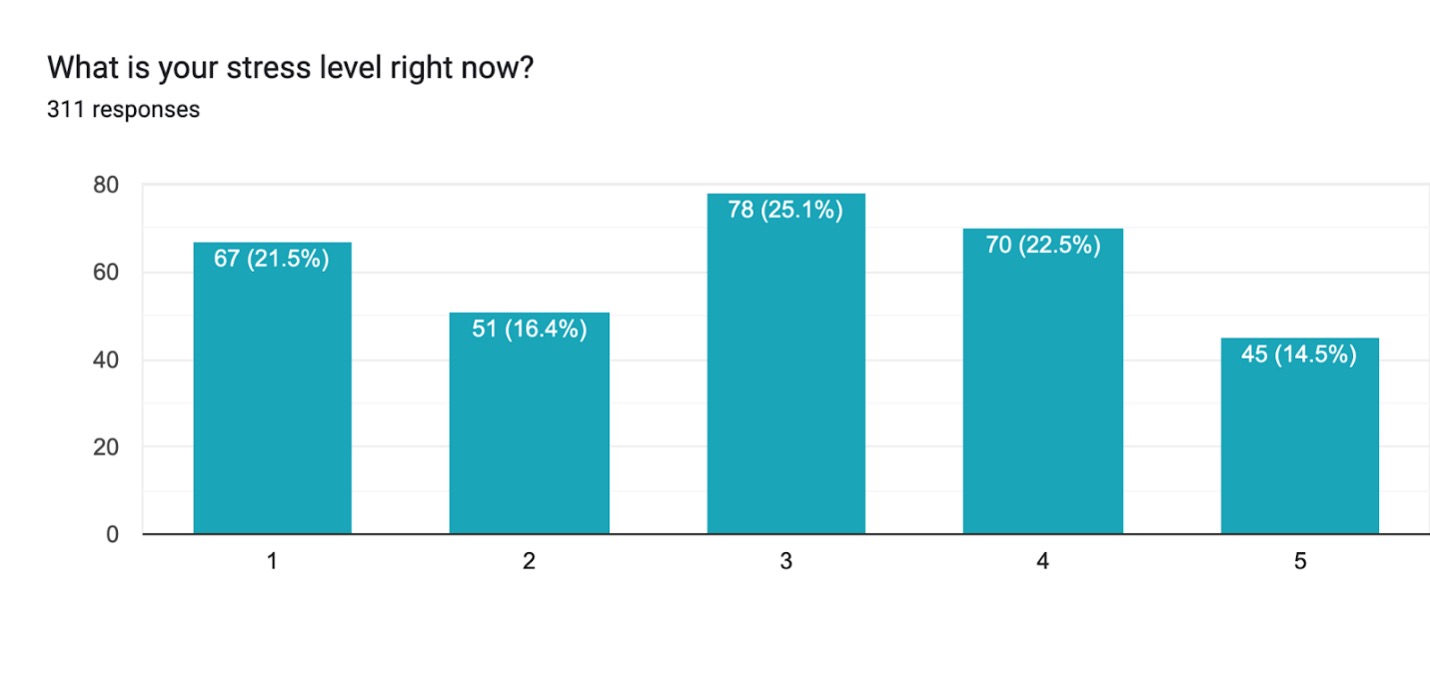 Figure 3.1
Figure 3.1
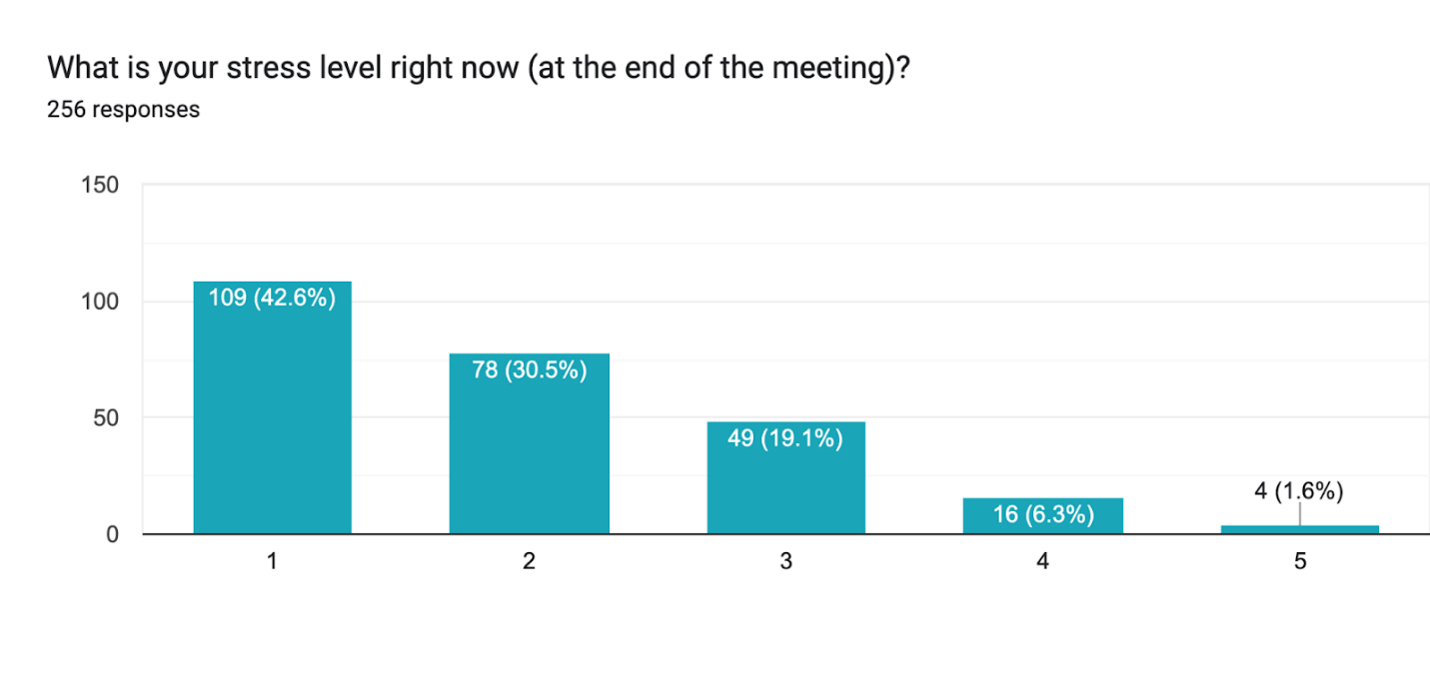 Figure 3.2
Figure 3.2
Reported increase in sense of belonging
While only two out of four rounds of sense of belonging surveys have been completed, 83.8% of students reported that they either Agree or Strongly Agree that they feel like they belong in Studio Sessions. (Figure 4.1) In the next two quarters, students will have the opportunity to take the survey twice more. Results will be analyzed and compared to assess the change in sense of belonging across the year. 73.5% of students reported that they feel much more connected or a little more connected to their peers. (Figure 4.2)
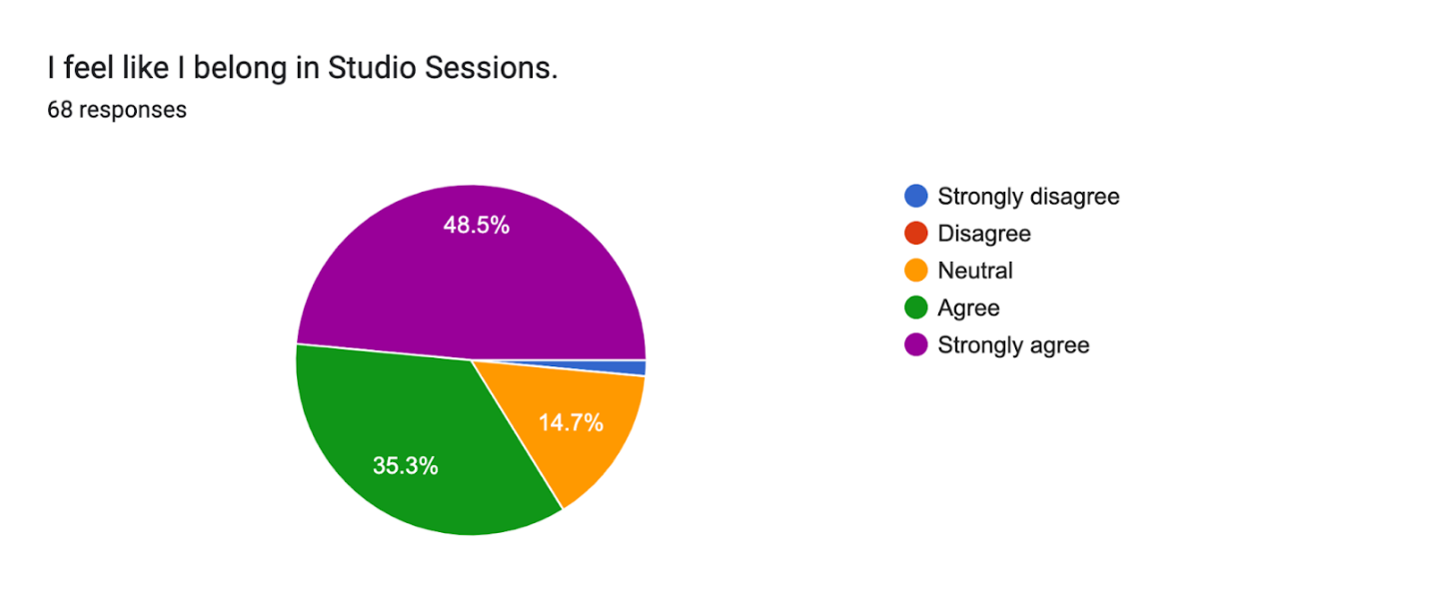 Figure 4.1
Figure 4.1
 Figure 4.2
Figure 4.2
Implications
Stress Levels
Stress level scores were self-reported on a 1-5 level scale with 5 indicating “extremely stressed” and 1 indicating “not stressed at all”. Average stress level scores for matched attendance data (N = 370) were calculated to be 2.91 before and a 1.98 after attending studio sessions (Table 4). The average stress levels for matched students (N = 66) were calculated as 2.8 before and 2.1 after (Table 5).
Results from the Wilcoxon Signed Rank Test showed that overall attendance stress scores were significantly higher before attending studio sessions compared to after (Z = -9.147, p <.001). Of the 370 attendances, 214 cases had lower median stress scores (sum of ranks = 32327) following the sessions, 68 had higher median stress levels, and 88 cases had the same before and after stress levels (Table 6).
Results for matched student stress scores from the Wilcoxon Signed Rank Test also showed that students’ stress scores were significantly higher before attending Studio Sessions compared to after (Z = 4.325, p <.001.) Out of 66 students, 44 students had lower median stress scores (sum of ranks= 1639) after Studio Sessions, 19 had higher median stress levels, and 3 students had the same before and after stress levels (Table 6).
When evaluating the average differences in stress scores between the middle and high school students, the independent sample t-test suggested that high school students’ stress levels lowered significantly more (M = -1.3241, SD = 1.46668) than middle school students’ stress levels (M = -.6927 , SD = 1.79914, t (346.299) = 3.665, p<.001) (Equal variances are not assumed).
Overall, stress levels were significantly lower after attending studio sessions. When comparing differences in stress levels across middle and high school students, high school students’ stress levels lower significantly more than middle school students’.
Sense of Belonging
Responses to multiple questions related to sense of belonging were collected using both weekly and quarterly check-in forms. A total of 471 responses were examined to determine students’ reasons for joining and/or returning to Studio Sessions weekly. Within these responses, 10 themes were identified (Table 7) and it was determined that there were two main reasons students join or return to studio sessions every week; social/emotional (N = 202) and art (N = 269) (Figure 1).
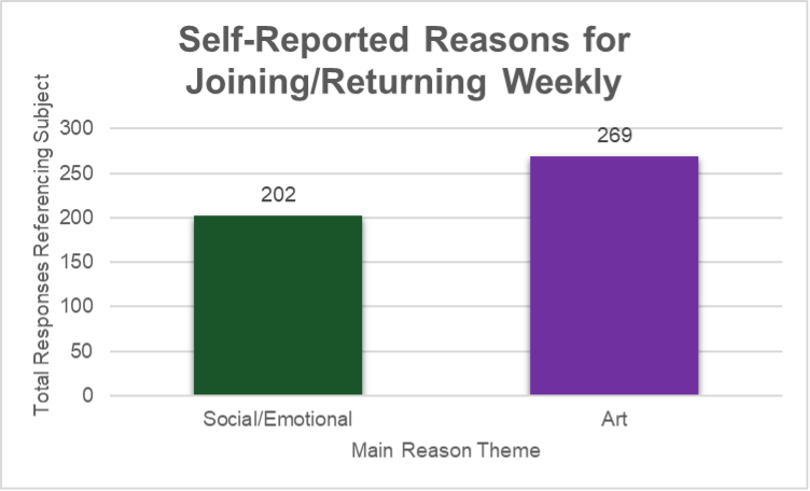 Figure 1
Figure 1
A total of 91 responses were collected across three quarterly check-in forms. On each form, students were asked three questions related to sense of belonging. Students were able to select from a range of responses that included “strongly agree”, “agree”, “neutral”, “disagree” and “strongly disagree”. Responses were counted and graphed to determine potential trends over time. When asked if students agreed with the statement “I feel like I belong” in studio sessions, 78 students agreed, 12 were neutral and one student disagreed (Figure 2).
 Figure 2
Figure 2
When asked if students agreed with the statement “I am making new friends” in studio sessions, 46 students agreed, 31 were neutral and 14 students disagreed. Positive trends were determined when reviewing the responses across the entire year (Figure 3).
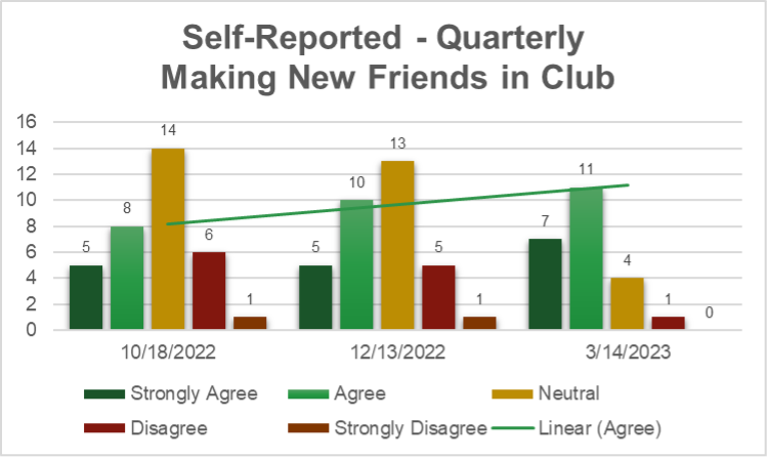 Figure 3
Figure 3
When asked to rank their connection level to other members of the club, students were able to respond using a range of “much more connected”, “a little more connected”, “no change”, “a little less connected”, to “much less connected”. A total of 69 students felt more connected to other club members, 21 felt no change in their connectedness and one felt a little less connected (Figure 4).
 Figure 4
Figure 4
Preliminary data related to sense of belonging shows positive trends in making new friends, connection levels to other club members and overall sense of belonging within the club.
Reflection
The data clearly demonstrates that providing a consistent space for students to simply create and interact with peers resulted in immediate decreased stress levels and, over the course of the school year, an increased sense of belonging. The importance of providing students with a space to create is underlined by the results of our project. Visual art is a powerful tool for stress relief; all students process their world and their emotions in a different way- flourishing when they find the perfect outlet to meet their expressive needs. Studio Sessions, a voluntary club, attracts students with an existing interest in the arts and provides a space for comraderie amongst student artists across grade levels, which developed a stronger sense of community. Students understood our club’s intentions and, as the weekly meetings went by, internalized the concept of setting aside time and space to nourish their creativity in a place where their work will be appreciated and their talents recognized.
References
Aggarwal, S. (2021). The Effect of Art and Music on Stress and Anxiety Levels in Adolescents. Indian Association of Health, Research and Welfare International Journal of Social Sciences, 9(3), 240-242.
Bone, J. K., Bu, F., Fluharty, M. E., Paul, E., Sonke, J. K., & Fancourt, D. (2022). Arts and Cultural Engagement, Reportedly Antisocial or Criminalized Behaviors, and Potential Mediators in Two Longitudinal Cohorts of Adolescents. Journal of Youth and Adolescence, 51, 1463-1482.
Harker Martin, B., & Colp, S. M. (2022). Art Making Promotes Mental Health: A Solution for Schools That Time Forgot. Canadian Journal of Education, 45(1), 156-183.
Lindsey, L., Robertson, P., & Lindsey, B. (2018). Expressive Arts and Mindfulness: Aiding Adolescents in Understanding and Managing Their Stress. Journal of Creativity in Mental Health, 13(3), 288-297.
Shorey, S., Ng, E. D., & Wong, C. H. J. (2022). Global prevalence of depression and elevated depressive symptoms among adolescents: A systematic review and meta-analysis. British Journal of Clinical Psychology, 61, 287-305.
